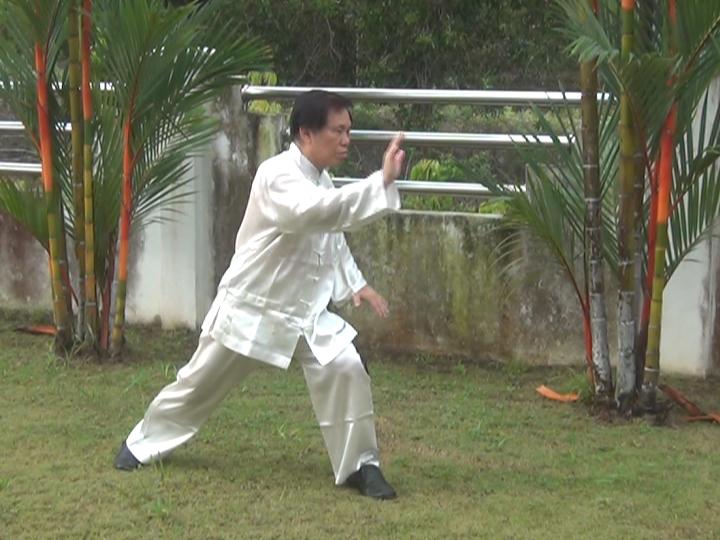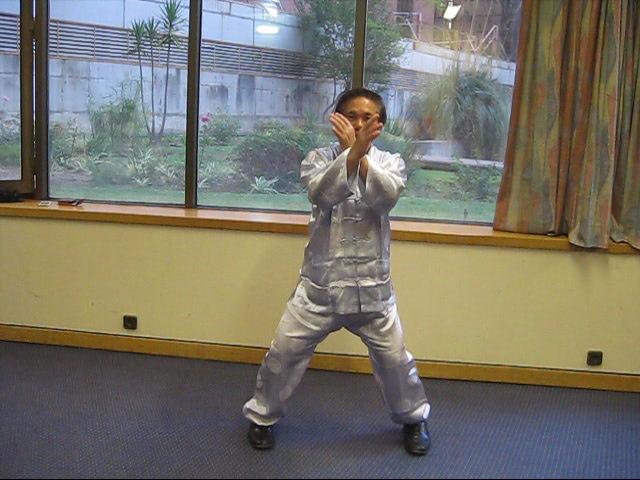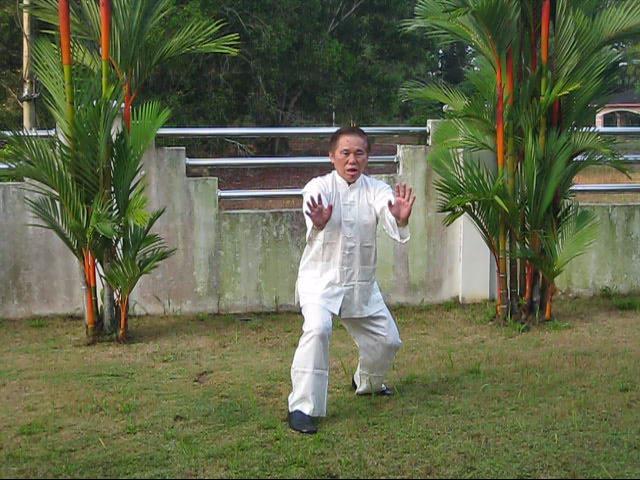KUNGFU SETS THAT COMPLEMENT THE IRON WIRE SET

For us, the 108-Pattern Yang Styl Taijiquan Set best complements the Iron Wire Set
Question
Which kungfu set best complements the Iron Wire set?
As you have mentioned before, some of the softer styles go against the powerful force-consolidating benefits of Iron Wire, as they are more 'flowing' in nature, and the benefits can cancel each other out.
Although we in Shaolin Wahnam are lucky enough to have the skills to interchange consolidation and flow of force, I would like to respectfully ask which set or sets directly complement Iron Wire and also, is it because they also consolidate or instead complement this consolidation with other aspects, ie, directing the consolidated force for other skills such as fa-jing, tiger-claw force, etc?
Dave, Spain
Answer
For us in Shaolin Wahnam, the set that best complements the Iron Wire Set is the 108-Pattern Yang Style Taijiquan Set. They are diagonally opposite. The Iron Wire Set is hard and consolidated, whereas the 108-Pattern Yang Style Taijiquan Set is soft and flowing.
But for most other people, these two sets directly negate each other. In other words, for most other people if they train the Iron Wire Set and the Taijiquan Set the same time, they get minimal benefit. For us if we train these two sets at the same time, we have maximum benefit. How does this interesting situation happen?
The method of Iron Wire is to consolidate internal force, whereas the method in Taijiquan is to let internal force flow. Hence the two opposing methods cancel each other's benefit.
Suppose an Iron Wire practitioner has consolidated 50 units of internal force after a session of Iron Wire training. In the next session when he practices Taijiquan he lets his 50 unites of internal force flow. Hence, at the beginning of the third session he has 0 units of consolidated internal force. After the session, he has consolidated 50 units. But in the fourth session he returns to 0 again when he lets the 50 units of force flow.
The same thing happens to a Taijiquan practitioner if he also trains Iron Wire at the same time. In the first session he develops 50 units of flowing force. But in the second session when he trains Iron Wire, he blocks up the force, leaving him 0 units of flowing force. In the third session he clears the blockage, but the flow is not strong enough to be a force. Hence he still has 0 units of flowing force. In the fourth session, be blocks up his force again. He remains with 0 units of flowing force.
Hence, if an Iron Wire practitioner also trains Taijiquan, and a Taijiquan practitioner also trains Iron Wire, at the end of the fourth training session both of them have 0 units of force. If they only train their chosen art, the Iron Wire practitioner will have 200 units of consolidated force, and the Taijiquan practitioner will have 200 units of flowing force, having developed 50 units of force per session.
The process is different for us in Shaolin Wahnam because of the magic of chi flow. When our practitioner trains Iron Wire in the first session he consolidates 50 units of internal force. When he trains Taijiquan in the second session, because of his skills in chi flow, he can convert the 50 units of consolidated force into flowing force, enlarging the flow. Hence, instead of developing 50 units of flowing force in this session as other practitioners do, our practitioner can develop 70 units of flowing force. Added to the 50 units of force developed in the first session, he now has 120 units of force by the end of the second session.

Press-force of Iron Wire Set
In the third session, he can convert this 120 units of flowing force into consolidated force, which enlarges the capacity of consolidation. Hence, instead of consolidating 50 units of force in this session as other practitioners do, he can consolidate 70 units. Added to the original 120 units, he now has 190 units. When he trains Taijiquan in the fourth session, he can convert 190 units of consolidated force into 190 units of flowing force, which further enlarges the volume of flow.
As the flow is more vigorous, it attracts more force from the Cosmos into his body. Hence, instead of developing 50 units of flowing force like the other practitioners do, due to the tremendous volume our practitioner can develop 80 units. Added to the original 190 units, by the end of the fourth session our Iron Wire practitioner has 270 unit of force, which he can convert into consolidated force or flowing force.
This is the same for our Taijiquan practitioner who also trains Iron Wire. Bu the end of the fourth session he has 270 units of force which he can convert to flowing force or consolidated force, whereas other Iron Wire practitioners and other Taijiquan practitioners have 200 units of consolidated force and 200 units of flowing force respectively. Not only our Iron Wire and Taijiquan practitioners have more force, their force is also versatile, can be converted to consolidated force or flowing force by will.
If our practitioners train only Iron Wire or only Taijiquan, they will have more force than other practitioners who trains only Iron Wire or only Taijiquan, but less force than our practitioners who trains both Iron Wire and Taijiquan. By the end of the fourth session our Iron Wire practitioners will have 240 units of consolidated force, and our Taijiquan practitioners will have 240 units of flowing force, but they are unable to convert one type of force to the other. They have more force than other practitioners because of the enlarging of their consolidating capacity or flow, but less force than our practitioners who train both Iron Wire and Taijiquan because of their lack of converting ability which can enhance the amount of force.
In our case all sets complement one another, though they benefit one another in different ways. In other words, it does not matter which particular set you choose, if you practice any other sets, these other sets will beneift your chosen set in various ways. This is the concept of spread and depth.
Let us take Iron Wire as the chosen set. The set that best complements Iron Wire is the 108-Pattern Yang Style Taijiquan Set. It is because they are diagonally opposite, and therefore have the widest range of interaction.
For other practitioners their interaction negates each other's benefit, but for us because of the magic of chi flow, the interaction complements each other. Hence the wider the interaction, the more benefits we get.
The contrast is not just in consolidating force and flowing force, but in many other aspects, like body movement, application of techniques and force, and use of tactics and strategies. For example, preferred movements in Iron Wire are short and straight, whereas those in Taijiquan are long and circular. A .preferred Iron Wire tactic is to press in with hard force, whereas that in Taijiquan is to yield, deflect then counter-strike
San Zhan of Wuzuquan is another interesting complement to the Iron Wire Set. All are internal sets. Iron Wire is hard and consolidated, Taijiquan is soft and flowing, whereas Zan Zhang is soft and consolidated. Hence, if we take Iron Wire and Taijiquan as two extreme ends of a spectrum, San Zhang is in between.
It is illuminating to compare Iron Wire with San Zhan. Both use short stances, whereas Taijiquan stances are long. Both are internal and hard, whereas Taijiquan is soft. But while Iron Wire is consolidated, San Zhan is flowing. Both sets are famous for developing tremendous internal force. Both sets look simple but are very profound.
The uninitiated would wonder how the patterns in the two sets could be used for combat. Relatively San Zhan looks more simple. And relatively the combat application of San Zhan are more profound.
The above question-answer is reproduced from the thread 10 Questions to Grandmaster Wong on the Iron Wire Set in the Shaolin Wahnam Discussion Forum

San Zhan of Wuzuquan
LINKS
